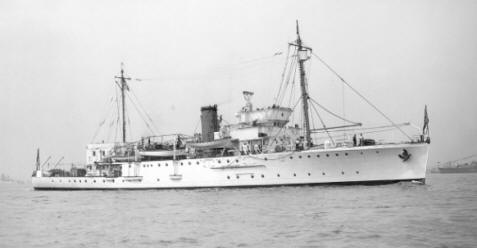
HMS Scott
(Wright & Logan 10631)
Summary of History
The second HMS SCOTT (J79) was a Survey Ship of
the Halcyon class, built by Caledon Shipbuilding Co., Dundee. Up to the
outbreak of war she was employed on survey work in connection with the
proposal to lay a Channel Mine Barrage and, during the first few months of
the war, she was employed in directing the minelayers in laying the
Barrage.
In October/November 1939 SCOTT was converted to an A/S vessel.
She kept the
big chartroom aft, but lost her mainmasts to topweight compensation. However
in April/May1940 she was converted back to a survey vessel. SCOTT
then carried out a number of important routine surveys in Home
Waters. She spent much of the next two years employed on mining, providing
precise positioning for the minelayers and, where necessary, carrying out
surveys of the intended minefields before they were laid to determine the
depth of water, and hence the length of mooring needed, as well as
measuring the tidal streams and currents which the minelayers could expect
to encounter. She was principally engaged on the northern barrage, between
Scotland, Iceland and Greenland. Only the week before the Bismarck's
break‑out in May 1941 SCOTT was in the waters the German squadron passed
through, surveying for the next tranche of the barrage. As well as
making the surveys to provide data before laying, SCOTT also herself
accompanied the minelaying sorties for the northern barrage.
In December 1941, she was the surveying ship for Operation 'Anklet' - the
second raid on the Lofoten Islands. In this operation she surveyed and
marked the narrow approach channel and the anchorage for use by the
British Forces taking part.
During the subsequent
withdrawal SCOTT collided with Arethusa, both ships sustaining slight
damage (stem broken and twisted to port). SCOTT spent most of 1942
surveying Scottish waters, apart from a few weeks in Iceland. Following a
refit SCOTT again returned to Scottsh waters for most of 1943, again with
two brief periods in Iceland.
In 1944 SCOTT took
part in two very cold invasion exercises in the Firth of Forth:
a battalion of infantry was landed on the beaches at Gullane,
and the port of Methil was 'taken' from the sea.
In June 1944, the ship sailed from Spithead in the van of Invasion
Fleet and D-Day found her laying marker buoys in the approaches to the
invasion beaches and charting obstructions and natural dangers off the
Normandy Coast. SCOTT also assisted with the
construction of the Mulberry Harbour at Arromanches by fixing the
positions of the Blockships and Phoenix Piers. Only a few days after this
harbour was compete, SCOTT's chart of Arromanches wartime harbour was available to the fleet.
Subsequently, SCOTT
was actively engaged in surveys of liberated ports and harbours, many of
them extensively damaged, including Morlaix, Boulogne, Brest and Dunkirk.
She also surveyed the points where the several PLUTOs (Pipe Lines Under
The Ocean) came ashore. With HMS Franklin she carried out surveys and
laid marker buoys in the Scheldt River, thus opening the port of Antwerp to
Allied shipping. On
13th October 1944 off Boulogne, five of SCOTT's crew were drowned when
they attempted to rescue three soldiers seen adrift in a dory during a
gale.
Post-war SCOTT
was employed on general hydrographic duties in Home Waters, locating and
sweeping many of the war-time wrecks and re-surveying large areas off the
coast of Great Britain. The ship finally paid off in late 1964 and was
sold on 24th June 1965 to West of Scotland Shipbreaking where she arrived
on 3rd July 1965.

